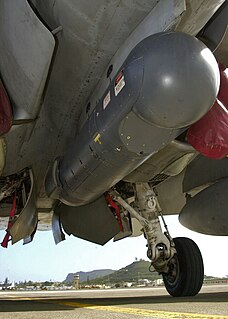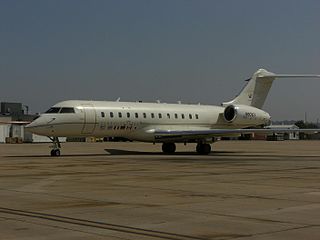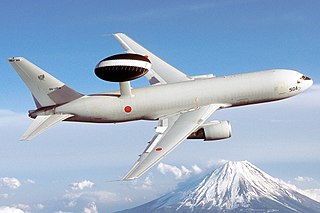
The Northrop Grumman E-8 Joint Surveillance Target Attack Radar System is a United States Air Force airborne ground surveillance, battle management and command and control aircraft. It tracks ground vehicles and some aircraft, collects imagery, and relays tactical pictures to ground and air theater commanders. The aircraft is operated by both active duty Air Force and Air National Guard units and also carries specially trained U.S. Army personnel as additional flight crew.

The Northrop Grumman RQ-4 Global Hawk is an unmanned (UAV) surveillance aircraft. It was initially designed by Ryan Aeronautical, and known as Tier II+ during development. The Global Hawk performs duties similar to that of the Lockheed U-2. The RQ-4 provides a broad overview and systematic surveillance using high-resolution synthetic aperture radar (SAR) and long-range electro-optical/infrared (EO/IR) sensors with long loiter times over target areas. It can survey as much as 40,000 square miles (100,000 km2) of terrain a day, an area the size of South Korea or Iceland.

The Northrop Grumman E-2 Hawkeye is an American all-weather, carrier-capable tactical airborne early warning (AEW) aircraft. This twin-turboprop aircraft was designed and developed during the late 1950s and early 1960s by the Grumman Aircraft Company for the United States Navy as a replacement for the earlier, piston-engined E-1 Tracer, which was rapidly becoming obsolete. The aircraft's performance has been upgraded with the E-2B, and E-2C versions, where most of the changes were made to the radar and radio communications due to advances in electronic integrated circuits and other electronics. The fourth major version of the Hawkeye is the E-2D, which first flew in 2007. The E-2 was the first aircraft designed specifically for its role, as opposed to a modification of an existing airframe, such as the Boeing E-3 Sentry. Variants of the Hawkeye have been in continuous production since 1960, giving it the longest production run of any carrier-based aircraft.

An airborne early warning and control (AEW&C) system is an airborne radar picket system designed to detect aircraft, ships and vehicles at long ranges and perform command and control of the battlespace in an air engagement by directing fighter and attack aircraft strikes. AEW&C units are also used to carry out surveillance, including over ground targets and frequently perform C2BM functions similar to an Air Traffic Controller given military command over other forces. When used at altitude, the radar on the aircraft allows the operators to detect and track targets and distinguish between friendly and hostile aircraft much farther away than a similar ground-based radar. Like a ground-based radar, it can be detected by opposing forces, but because of its mobility, it is much less vulnerable to counter-attack.
The Northrop Grumman E-10 MC2A was planned as a multi-role military aircraft to replace the Boeing 707-based E-3 Sentry and E-8 Joint STARS, the Boeing 747-based E-4B, and the RC-135 Rivet Joint aircraft in US service. The E-10 was based on the Boeing 767-400ER commercial airplane.

The AN/AAQ-28(V) LITENING targeting pod is an advanced precision targeting pod system currently operational with a wide variety of aircraft worldwide. The research and development of the LITENING was first undertaken by Rafael Advanced Defense Systems' Missiles Division in Israel, with subsequent completion of LITENING I for use in the Israeli Air Force.
Link 16 is a military tactical data link network used by NATO and nations allowed by the MIDS International Program Office (IPO). Its specification is part of the family of Tactical Data Links.
The Doomsday Plane is an unofficial denomination of a class of aircraft which is used as an Airborne Command Post in an event of nuclear war, disaster or other large scale conflict which threatens key military and government infrastructure.

The Battlefield Airborne Communications Node (BACN) is a United States Air Force (USAF) airborne communications relay and gateway system carried by the unmanned EQ-4B and the manned Bombardier E-11A aircraft. BACN enables real-time information flow across the battlespace between similar and dissimilar tactical data link and voice systems through relay, bridging, and data translation in line-of-sight and beyond-line-of-sight situations. Its ability to translate between dissimilar communications systems allows them to interoperate without modification.

The Multi-Platform Radar Technology Insertion Program (MP-RTIP), a U.S. Air Force project led by contractor Northrop Grumman to develop the next generation of airborne air-to-air and air-to-ground radar systems. While initially planned for multiple platforms, the MP-RTIP is currently intended only for the RQ-4B Global Hawk UAV.

The Boeing E-767 is an Airborne Warning and Control System (AWACS) aircraft. It was designed in response to the Japan Air Self-Defense Force's requirements, and is essentially the Boeing E-3 Sentry's surveillance radar and air control system installed on a Boeing 767-200.

The EADS/Northrop Grumman KC-45 was a proposed aerial refueling tanker aircraft based on the Airbus A330 MRTT. The United States Air Force (USAF) had ordered 179 KC-45As in the first stage of replacing the aging Boeing KC-135 Stratotanker tankers currently in service. However, the contest was reopened in July 2008, after Boeing's protest of the award was upheld. In response to the new contest, on 8 March 2010, Northrop Grumman announced it was abandoning its bid for the new contract, with its CEO stating that the revised bid requirement favoured Boeing. On 20 April 2010, EADS announced it was re-entering the competition and entered a bid with the KC-45. Eventually, the USAF selected the Boeing KC-46 Pegasus.
The United States Missile Defense Agency (MDA) is developing a Space Tracking and Surveillance System (STSS) which it will use to research the space-based detection and tracking of ballistic missiles. Data from STSS satellites could allow interceptors to engage incoming missiles earlier in flight than would be possible with other missile detection systems. The STSS program began in 2001, when the "SBIRS Low" program was transferred to MDA from the United States Air Force.
Airborne ground surveillance (AGS) refers to a class of military airborne radar system used for detecting and tracking ground targets, such as vehicles and slow moving helicopters, as opposed to Airborne early warning and control, whose primary role is detecting and tracking aircraft in flight. Antenna beam width should be very small to enhance resolution. This antenna size limitation demands high frequency of operation, to be operated in this mode. AGS radar is typically a medium or low power radar. It includes both maritime and land surveillance. Today, UAVs perform this operation, which often uses optical aids for surveillance.
Alliance Ground Surveillance (AGS) is a NATO programme to acquire an airborne ground surveillance capability.

The AN/TPS-80 Ground/Air Task Oriented Radar (G/ATOR) is the United States Marine Corps next generation Air Surveillance/Air Defense and Air Traffic Control (ATC) Radar. The mobile active electronically scanned array radar system is currently being developed by Northrop Grumman and was expected to reach initial operating capability in August 2016.

The Northrop Grumman B-21 Raider is an American heavy bomber under development by Northrop Grumman. As part of the Long Range Strike Bomber program (LRS-B), it is to be a very long-range, stealth strategic bomber for the United States Air Force capable of delivering conventional and thermonuclear weapons.











